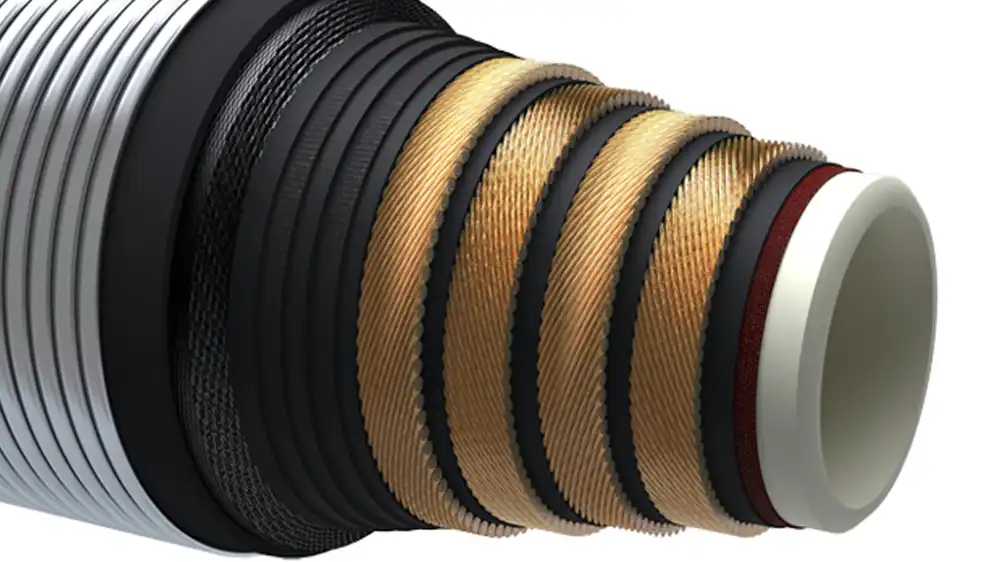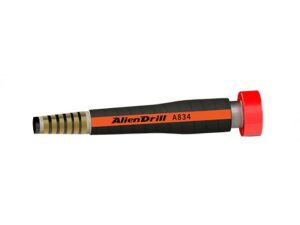For oil and gas exploration, safety and efficiency are paramount. Every component used in drilling operations must meet stringent standards to ensure smooth operations and protect personnel and the environment. One such crucial component is the choke and kill hose.
What is a Choke and Kill Hose?
A choke and kill hose is a high-pressure conduit that serves a critical function in drilling operations. It is specifically designed to control the flow of fluids during well control procedures.
This vital piece of equipment plays a pivotal role in preventing blowouts and managing well pressure, thereby safeguarding both personnel and assets.
High Pressure Oil Field Hose Choke and Kill

The high-pressure oil field hose, commonly referred to as the choke and kill hose, is a specialized conduit designed to withstand extreme conditions encountered in drilling operations.
Its primary function revolves around controlling the flow of fluids within the wellbore, particularly during critical phases such as well control procedures.
Choke Functionality
The term “choke” in the context of drilling operations refers to the process of regulating the flow of fluids from the well. The choke and kill hose facilitates this function by allowing operators to precisely adjust the rate of fluid circulation. This control over fluid flow is essential for maintaining optimal pressure levels within the wellbore, thereby preventing potential hazards such as blowouts or uncontrolled releases of hydrocarbons.
Kill Capability
In the event of an unexpected influx of fluids, commonly known as a kick or blowout, the kill function of the hose becomes paramount. The choke and kill hose swiftly and effectively shuts off the flow of fluids, aiding in regaining control over the well and mitigating potential risks to personnel, equipment, and the environment.
Material Composition
These hoses are typically crafted from a combination of high-strength materials such as steel, rubber, and thermoplastics. Each material serves a specific purpose:
- Steel: Provides structural integrity and reinforcement to withstand high pressures and temperatures.
- Rubber: Acts as a sealing and protective element, offering flexibility and resistance to abrasion.
- Thermoplastics: Enhance flexibility and resistance to chemical corrosion, crucial in challenging drilling environments.
Layered Design
Choke and kill hoses feature a layered construction, with each layer serving a distinct purpose:
- Inner Tube: Acts as the conduit for fluid flow, often made of synthetic rubber or thermoplastic materials.
- Reinforcement Layers: Provide structural support, typically composed of high-tensile steel wire or textile materials.
- Outer Cover: Offers protection against abrasion, impact, and environmental factors, typically made of synthetic rubber or thermoplastics.
Material Selection
Choke and kill hoses are typically constructed from a combination of high-quality materials chosen for their durability, flexibility, and resistance to various environmental factors. Common materials used in the construction of these hoses include:
Steel
Steel components, such as reinforcement layers and end fittings, provide structural integrity and strength to choke and kill hoses. High-grade steel alloys are chosen to withstand high pressures and extreme temperatures encountered during drilling operations.
Rubber
Rubber layers serve as the primary sealing and protection elements in choke and kill hoses. These layers are designed to provide flexibility, abrasion resistance, and sealing properties, ensuring the containment of fluids under high pressure.
Thermoplastics
Thermoplastic materials are often incorporated into choke and kill hose construction to enhance flexibility and resistance to chemical corrosion. These materials help maintain hose integrity in challenging drilling environments where exposure to corrosive fluids is common.
Choke and Kill Hose Construction and Design

The construction and design of choke and kill hoses are paramount aspects that contribute to their effectiveness and reliability in oil and gas drilling operations.
These hoses are meticulously engineered to withstand the harsh conditions encountered in drilling environments while ensuring the safe and efficient flow of fluids. Let’s delve into the key elements of choke and kill hose construction and design:
Choke and kill hoses feature a multi-layered construction designed to provide optimal performance and durability. The typical layered configuration of these hoses includes:
Inner Tube
The inner tube serves as the conduit through which fluids flow during drilling operations. It is commonly made of synthetic rubber or thermoplastic materials that are compatible with the fluids being conveyed.
Reinforcement Layers
Reinforcement layers, typically made of high-tensile steel wire or textile materials, provide structural support and prevent hose collapse under high pressure. These layers are strategically placed to withstand axial and radial loads encountered during operation.
Cover
The outer cover of choke and kill hoses acts as a protective barrier against abrasion, impact, and environmental hazards. It is usually made of synthetic rubber or thermoplastic materials with excellent weather and UV resistance properties.
End Fittings
Choke and kill hoses are equipped with end fittings that facilitate the connection to drilling equipment and ensure a secure seal. These fittings are typically made of steel or other high-strength materials and are designed to withstand high-pressure environments without leaking or failing.
Compliance with Standards
Choke and kill hoses must adhere to industry standards and regulations to ensure their performance and safety. Manufacturers follow specifications such as API Specification 16C, which sets guidelines for the design, manufacture, and testing of choke and kill equipment. Compliance with these standards is essential to ensure the reliability and integrity of choke and kill hoses in demanding drilling operations.
Functionality
The primary function of a choke and kill hose is to regulate the flow of fluids, including oil, gas, and drilling mud, in the wellbore. During drilling operations, the hose controls the rate of fluid circulation, allowing operators to adjust pressure levels as needed. In the event of a kick or blowout, the choke and kill hose can quickly and effectively halt the flow of fluids, helping to regain control of the well.
Importance in Drilling Operations
Well Control
Choke and kill hoses are integral to well control procedures, which are essential for maintaining safe and efficient drilling operations. By regulating fluid flow and pressure, these hoses help prevent dangerous situations such as blowouts, kicks, and uncontrolled releases of hydrocarbons.
Safety
The safety of personnel and assets is paramount in the oil and gas industry. Choke and kill hoses play a crucial role in ensuring the well-being of workers and protecting equipment from damage. By providing reliable fluid control, these hoses help mitigate risks and uphold safety standards on drilling rigs.
Environmental Protection
In addition to safeguarding personnel and assets, choke and kill hoses also play a vital role in environmental protection. By preventing the uncontrolled release of fluids into the surrounding environment, these hoses help minimize the risk of pollution and ecological damage.
Compliance and Standards
Choke and kill hoses must meet stringent industry standards and regulatory requirements to ensure their effectiveness and reliability. Manufacturers adhere to specifications such as API Specification 16C, which establishes guidelines for the design, manufacture, and testing of choke and kill equipment.
Choke and Kill Hose Applications

Choke and kill hoses are versatile components that find extensive applications in various facets of oil and gas drilling operations. Their robust construction, precise functionality, and reliability make them indispensable in ensuring safety, efficiency, and environmental protection. Let’s delve into some of the key applications of choke and kill hoses:
Well Control Procedures
Choke and kill hoses play a pivotal role in well control procedures, which are critical for maintaining safe and efficient drilling operations. During drilling, these hoses regulate the flow of fluids, including oil, gas, and drilling mud, within the wellbore. By controlling fluid circulation and pressure levels, choke and kill hoses help prevent dangerous situations such as blowouts, kicks, and uncontrolled releases of hydrocarbons.
Pressure Management
Managing pressure is essential in oil and gas drilling operations to prevent equipment damage and ensure the safety of personnel. Choke and kill hoses provide operators with precise control over fluid flow rates, allowing them to adjust pressure levels as needed. Whether it’s reducing pressure to avoid formation damage or quickly shutting off flow during an emergency, these hoses are instrumental in maintaining optimal pressure conditions in the wellbore.
Kick Detection and Mitigation
Kicks, which occur when formation fluids enter the wellbore, pose significant risks to drilling operations. Choke and kill hoses aid in kick detection and mitigation by allowing operators to monitor and regulate fluid flow in real-time. In the event of a kick, these hoses can be used to quickly shut off flow and regain control of the well, preventing potential blowouts and ensuring the safety of personnel and equipment.
Well Testing and Completion
Choke and kill hoses are also utilized during well testing and completion activities. These hoses facilitate the flowback of fluids from the wellbore to the surface, allowing operators to assess reservoir properties and determine the viability of the well. Additionally, choke and kill hoses are employed in the final stages of well completion to ensure smooth and controlled fluid flow during production operations.
Emergency Response
In emergency situations such as blowouts or equipment failures, choke and kill hoses are critical components of the response strategy. These hoses enable rapid shutdown of fluid flow, helping to contain and mitigate the impact of the incident. Their reliability and responsiveness are essential for minimizing risks and ensuring the safety of personnel and the environment.
Conclusion
In conclusion, choke and kill hoses are indispensable components in oil and gas drilling operations. Their ability to regulate fluid flow and pressure is critical for maintaining safety, efficiency, and environmental protection on drilling rigs. By understanding the importance and functionality of these hoses, operators can ensure the success of their drilling projects while prioritizing the well-being of personnel and the environment.
The choke and kill hose stands as a cornerstone of safety and efficiency in oil and gas drilling operations. With its robust construction, precise functionality, and versatile applications, it ensures the smooth flow of operations while safeguarding personnel and the environment. And remember, you can always rely on us to provide the choke and kill hose at any time with a competitive price.






